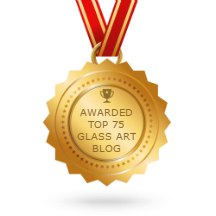I saw a picture of a beautiful bowl done by Martha Calabrese showing a nice scalloped edge and had to give it a try. In an effort to not waste glass though, I decided to try small and focused on making a sun catcher. I will have to admit that this process is very finicky so I am not sure how often I will do scalloped edges in the future or even go bigger as I would really hate to waste a large sheet of glass. However, it makes a really nice edge and something different, so it was well worth the adventure.
Typical of beginners luck, my first one came out great. I cut a circle of pink opaque and then took this to my ring saw. I wasn’t quite sure how deep to make cuts around the circle so went with 3/8” deep cuts and tried to keep them even. I later figured out that it would be better to make myself a template to ensure I was more even both in my depth of cuts as well as distance around the circle. I then cut a small circle of white for the center, so the center is 6mm glass and the outside edge is only 3mm.
I then fired this to 1465 degrees F where 1460 degrees F is my typical plate fusing temperature in that specific kiln. It came out great. I did have some needles around the scallops which I ground with a small scrap of diamond sanding cloth and then fire polished this at the same time I fused the decal onto it at 1350 degrees F.
I had an extra circle of 2mm spring green transparent which I had not used and decided to try that next using the same similar technique but measuring the scallops better this time. taking the depth to 1/2″ Since this one was 2mm for the base and 3mm for the center, I took it only to 1450 degrees F, but I think this was just too hot for the 2mm glass and it did not work at all.
I then made some tests using clear so I didn’t waste more colored glass and found that really the most reliable thicknesses were 3mm of both the outside and the inside glass pieces. Further testing also proved that the best temperature for my kiln is 1460 degrees F is the base is opaque glass and 1450 degrees F is the base glass is transparent.
I also played around with depths of the cuts as I thought that I had read that Martha cut about 5/8” – 3/4”. For my small circles, 1/2” deep cuts gave me the best results in the transparent, whereas I could get away with 3/8” cuts in opaque glass.
Here is my final sun catcher which was my goal all along as I wanted to create a special gift for someone. This one has sea blue transparent glass as the base and cream glass for the center with a sepia decal of our local bridge fused on to it.
Lessons learned:
- A template worked best to ensure even depths of cut and distance around the perimeter.
- Opaque can fire hotter than transparent.
- 3mm for both layers of glass works best.
NOTE: I learn much of what I know from reading other websites, classes and blogs and hence, I haven’t really invented anything new here. But I am sharing what I found to work and not work. If you have found other ways to do something similar to this, please share. Thanks!




